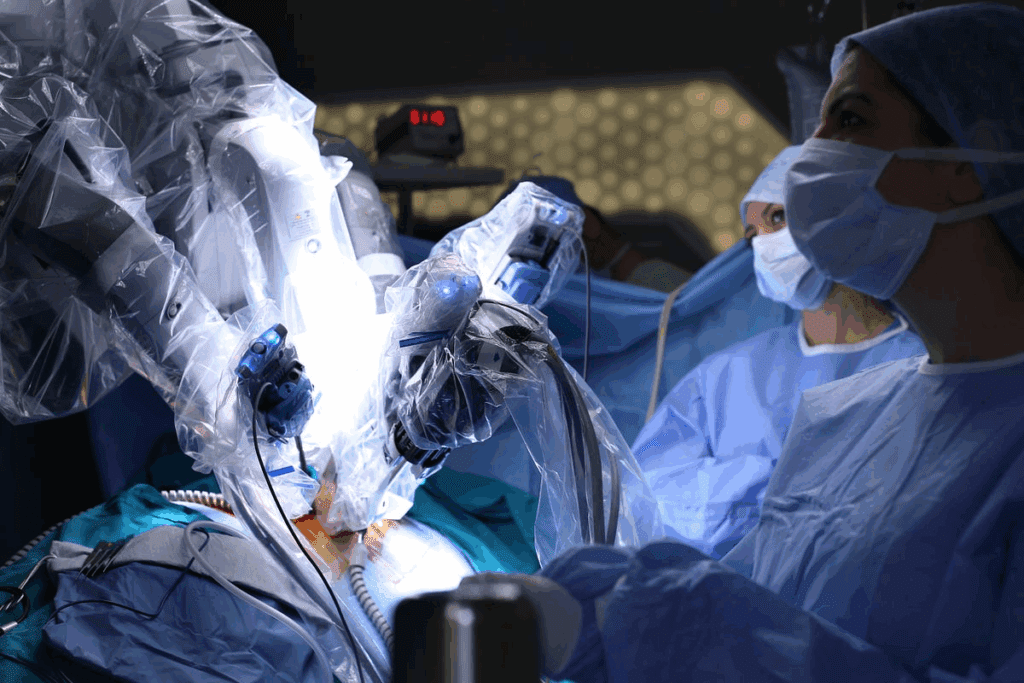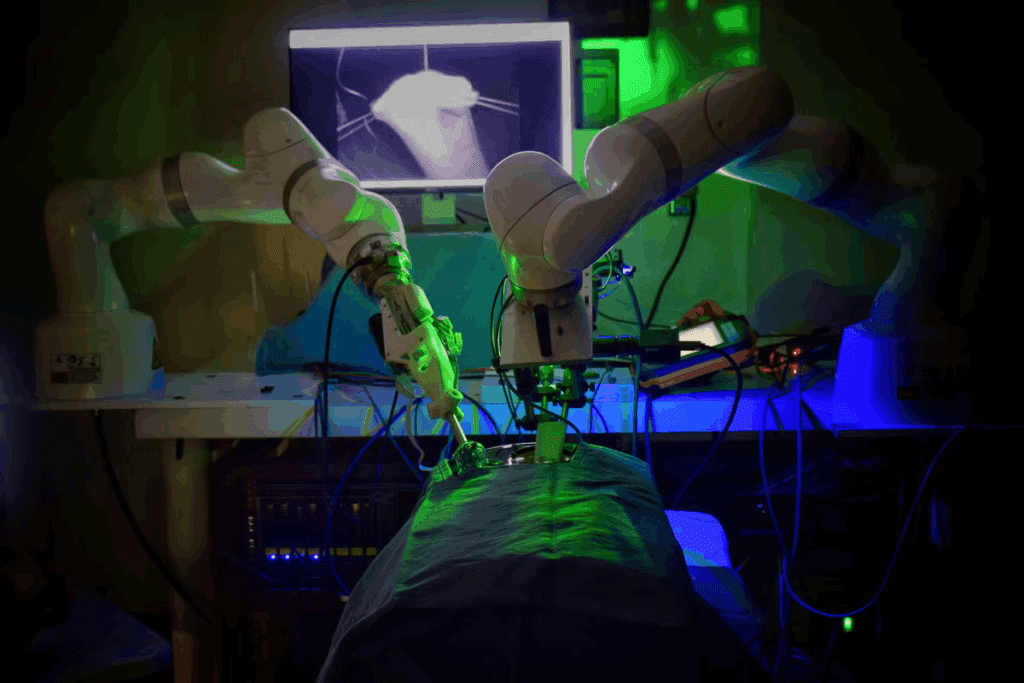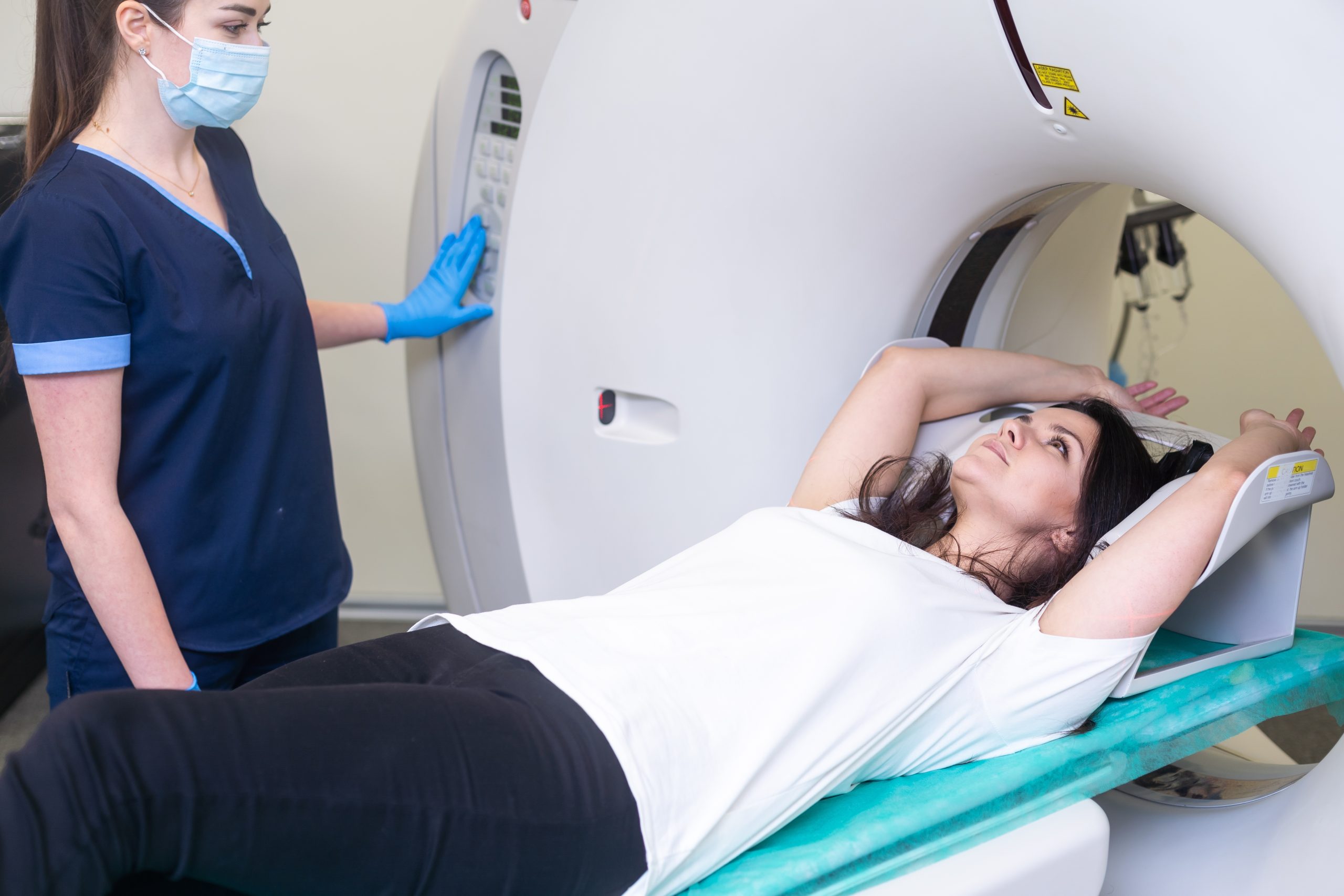Last Updated on November 27, 2025 by Bilal Hasdemir

Robotic hysterectomy has changed how surgeons remove the uterus. It’s a less invasive method that leads to faster recovery. Millions of women undergo uterus removal robotic hysterectomy every year. This technique uses small incisions and robotic tools to precisely remove the uterus, resulting in less blood loss, less pain, smaller scars, and shorter hospital stays compared to traditional open surgeries. Recovery time is typically shorter, with many patients returning to normal activities within a few weeks. Understanding uterus removal robotic hysterectomy is important for women considering this surgery, as it offers a safer and more comfortable option.
In a robotic hysterectomy procedure, the surgeon focuses on removing the uterus safely. They use small incisions for the robotic arms. This allows for precise work. But where exactly does the uterus come out? The answer depends on the surgical team’s careful planning.
Knowing the details of the surgery can ease worries. We’ll explain everything, so you understand the process fully.
Key Takeaways
- The robotic hysterectomy procedure is a minimally invasive surgical technique.
- It involves the use of robotic arms to facilitate precise uterus removal.
- Small incisions are made to insert the robotic arms, reducing recovery time.
- The surgical team carefully plans the procedure to ensure safe extraction.
- Understanding the process can help alleviate patient concerns.
Understanding Robotic Hysterectomy: A Modern Surgical Approach

Robotic hysterectomy is a big step forward in gynecological surgery. It offers a less invasive option compared to old methods. Knowing about this modern surgery is key in women’s health.
What is a Hysterectomy?
A hysterectomy removes the uterus. It’s done for many reasons, like uterine cancer or fibroids. Doctors usually try other treatments first.
There are different types of hysterectomies. Each has its own reasons and surgical details. The right procedure depends on the condition and the patient’s health.
Evolution of Hysterectomy Techniques
Hysterectomy methods have changed a lot. Old methods used big cuts, but now we have laparoscopic and robotic surgeries. These new ways are better because they’re less invasive.
These new methods have smaller cuts, less blood loss, and faster recovery. They show our effort to make surgery better for patients.
Introduction to Robotic-Assisted Surgery
Robotic-assisted surgery, like robotic hysterectomy, uses advanced systems. The Da Vinci system is a big name in this field. It helps surgeons see better and work more precisely.
The Da Vinci system is great for complex surgeries. It helps with detailed work, which can lead to better results.
| Technique | Incision Size | Recovery Time | Blood Loss |
| Traditional Open Hysterectomy | Large | Longer | Significant |
| Laparoscopic Hysterectomy | Small | Shorter | Less |
| Robotic-Assisted Hysterectomy | Very Small | Shortest | Minimal |
Robotic hysterectomy is a big leap in surgery for women. It’s precise, has quick recovery, and leaves small scars. It’s a great choice for many patients.
Indications for Robotic Hysterectomy

Some medical conditions need a hysterectomy, and robotic surgery is often the best choice. This method is known for its precision and is less invasive. It’s a top pick for treating many gynecological issues.
Medical Conditions Requiring Hysterectomy
Many conditions might lead to a hysterectomy. These include uterine fibroids, endometriosis, uterine prolapse, and some cancers. Uterine fibroid removal is a common reason for this surgery. We’ll look at these conditions and how robotic surgery helps.
Uterine fibroids can cause a lot of pain and heavy bleeding. Endometriosis is a painful condition where tissue grows outside the uterus. Uterine prolapse happens when the uterus slips out of place. These issues can really affect a woman’s life, and surgery is often considered when other treatments don’t work.
When Robotic Approach is Recommended
Robotic surgery is chosen for many reasons. It leads to less blood loss, shorter hospital stays, and quicker recovery. It also allows for more precise surgery, lowering the risk of problems.
The benefits of robotic hysterectomy include:
- Minimally invasive procedure
- Less postoperative pain
- Reduced risk of infection
- Shorter recovery period
- Cosmetic benefits due to smaller incisions
Patient Selection Criteria
Not every patient is right for robotic hysterectomy. We look at the severity of the condition, the patient’s health, and past surgeries. Each case is evaluated to see if robotic surgery is the best choice.
| Condition | Robotic Hysterectomy Benefits | Patient Selection Criteria |
| Uterine Fibroids | Minimally invasive, less blood loss | Size and location of fibroids, overall health |
| Endometriosis | Precise dissection, reduced risk of complications | Severity of endometriosis, previous surgeries |
| Uterine Prolapse | Shorter recovery time, less postoperative pain | Degree of prolapse, patient’s overall health |
By carefully choosing patients and using robotic surgery, we can offer effective treatment. This approach leads to fewer complications and faster healing.
Preparation for Robotic Hysterectomy
Getting ready for a robotic hysterectomy is key to a good outcome. This step is important for both the patient and the surgical team. It sets the stage for a successful surgery.
Pre-surgical Evaluations
Before surgery, several checks are done to see how the patient is doing. These include:
- Medical History Review: Looking at the patient’s past health to see if it might affect the surgery or recovery.
- Physical Examination: A full check-up to see how the patient is currently.
- Imaging Tests: Tests like ultrasound or MRI to get detailed pictures of the uterus and nearby areas.
- Laboratory Tests: Blood tests and other lab work to check the patient’s blood and health markers.
Patient Preparation
Getting ready as a patient is a big part of the robotic hysterectomy process. We tell patients to:
- Follow Pre-operative Instructions: Follow specific rules about eating, drinking, and taking medicine before surgery.
- Arrange for Post-operative Care: Make plans for someone to drive them home and stay for at least 24 hours.
- Stop Certain Medications: Stop taking some medicines that could affect the surgery or recovery.
Anesthesia Considerations
Thinking about anesthesia is a big part of the robotic hysterectomy. Our anesthesiologists work with the surgical team to:
- Determine the Best Anesthesia Option: Choose the right anesthesia based on the patient’s health and the surgery details.
- Monitor Patient Comfort: Watch how the patient is feeling during the surgery and adjust the anesthesia as needed.
By preparing well for the robotic hysterectomy, we can lower risks and help the patient recover better.
The Da Vinci Robotic System for Gynecologic Surgery
The Da Vinci Robotic System has changed gynecologic surgery with its cutting-edge tech and precision. It’s a big step forward in surgical care, bringing many benefits to patients and surgeons.
System Components and Setup
The Da Vinci System has several important parts, like the surgeon console, patient cart, and vision cart. These are set up to work together perfectly, ensuring top performance during surgeries.
Key components include:
- Surgeon console: Gives the surgeon a clear, 3D view of the surgery area and easy controls.
- Patient cart: Holds the robotic arms that do the surgery, allowing for precise and smooth movements.
- Vision cart: Has the camera and light for a sharp view of the surgery area.
Surgeon Console and Controls
The surgeon console is the heart of the Da Vinci System, where surgeons control the robotic arms. They use hand controls and foot pedals, making complex surgeries easier and more comfortable.
Advantages Over Traditional Laparoscopy
The Da Vinci System beats traditional laparoscopy in many ways, including:
- Clearer 3D high-definition images
- More precise and skilled movements with wristed instruments
- Less tremor and fatigue for the surgeon
- Better patient results with less blood loss and fewer problems
Training Requirements for Surgeons
To use the Da Vinci System well, surgeons need thorough training. They learn both the theory and practice, including how to use the system and perform surgeries. Regular training keeps surgeons up-to-date and skilled in using this advanced tech.
The Robotic Hysterectomy Procedure: Step by Step
Knowing the steps of robotic hysterectomy is key for those thinking about it. It’s a detailed process with several important stages.
Patient Positioning
The first step in the robotic hysterectomy procedure is patient positioning. The patient lies in a lithotomy position for better access to the pelvic area. This setup is vital for the patient’s safety and comfort during surgery.
Port Placement
After positioning, the team places ports in the abdomen. These are small incisions for the robotic instruments. They allow the surgeon to do the laparoscopic hysterectomy with great accuracy.
Docking the Robot
With ports in place, the robotic system is docked. This means aligning the robotic arms with the ports. It’s a precise step to ensure smooth operation of the robotic system.
Initial Surgical Steps
The first surgical steps are to inspect the pelvic area and find the key anatomy. The surgeon uses the robotic system to dissect and move the uterus. This is a critical part of the procedure.
As the surgery goes on, the surgeon detaches the uterus from nearby tissues. The robotic system helps with better vision and control. This reduces the chance of complications.
The robotic hysterectomy procedure is a complex surgery with many benefits. Understanding the steps helps patients see the skill and precision needed for this surgery.
Uterus Removal in Robotic Hysterectomy: The Extraction Process
Robotic hysterectomy is a precise way to remove the uterus. It’s key to a successful surgery, aiming for few complications and the best results for patients.
Detachment of the Uterus
The first step is detaching the uterus from nearby tissues. Surgeons use the Da Vinci Robotic System for this. It helps cut down on blood loss and damage to other organs. The robotic system’s advanced vision and skill make detachment safer.
Common Extraction Routes
There are several ways to remove the uterus during robotic hysterectomy. The choice depends on the uterus size, patient’s body, and surgeon’s choice. Common paths include:
- Vaginal extraction, which is less invasive.
- Extraction through a small abdominal incision for bigger uteri.
Choosing the right path helps surgeons meet each patient’s unique needs.
Specimen Containment Methods
To keep the uterus safe during removal, containment methods are used. The uterus is put in a bag, then taken out through a chosen path. Keeping the uterus in a bag is very important, mainly when there’s a chance of cancer or tumors.
The uterus removal process in robotic hysterectomy shows how far surgery has come. It’s safer and more precise. Knowing about these steps helps patients understand the benefits and complexity of robotic surgery.
Vaginal Cuff Closure and Completion
The final stages of a robotic hysterectomy are key. They involve closing the vaginal cuff and a thorough check. We make sure everything is done right and securely.
Techniques for Vaginal Cuff Closure
Closing the vaginal cuff is a precise step. We use advanced robotic tools to stitch it up. This method is more precise than old ways.
Key techniques include:
- Continuous suturing for a secure closure
- Use of absorbable sutures to minimize complications
- Careful inspection to ensure hemostasis
Final Inspection
After closing the vaginal cuff, we do a detailed final check. We look for bleeding, make sure the cuff is tight, and check for tissue injuries.
The final inspection is a critical quality control step that helps in identifying any issues early. This allows for quick action if needed.
Undocking and Port Removal
The last steps are undocking the robot and taking out the ports. We make sure the robot is safely pulled back. Then, we remove the ports carefully to avoid harm.
Care is taken to:
- Minimize trauma to the abdominal wall
- Ensure complete removal of all instruments and ports
- Inspect the port sites for any bleeding or complications
By following these steps carefully, we ensure a safe and effective end to the robotic hysterectomy.
Benefits of Uterus Removal Through Robotic Hysterectomy
Robotic-assisted laparoscopic hysterectomy is now a top choice for many. It offers big advantages for both patients and surgeons. The Da Vinci Robotic System has changed how hysterectomies are done, making them better than old methods.
Precision and Visualization Advantages
The robotic system brings enhanced precision and visualization. This means surgeons can do complex tasks more accurately. The 3D high-definition view helps them see the area clearly, helping them avoid damaging important parts.
Reduced Blood Loss
Robotic hysterectomy also means less blood loss during surgery. The careful cutting and small incisions cause less harm to the patient. This leads to fewer problems and a quicker healing time.
Shorter Hospital Stays
Patients who have robotic hysterectomy usually stay in the hospital shorter than those with open surgery. The small cuts and less pain mean they can get back home faster.
Cosmetic Benefits
The robotic method also has cosmetic benefits. It uses smaller cuts than open surgery. This means less scarring and happier patients with their surgery results.
In summary, robotic hysterectomy has many benefits. It offers better precision, less blood loss, shorter hospital stays, and looks better. These advantages lead to better results and faster recovery for patients, making it a popular choice.
Comparing Extraction Methods in Different Hysterectomy Approaches
The way the uterus is removed is key in hysterectomy surgery. It affects the surgery’s success and how quickly the patient recovers. We’ll look at how different hysterectomy methods handle uterus removal.
Traditional Abdominal Hysterectomy Extraction
Traditional abdominal hysterectomy uses a big cut in the belly to get to the uterus. The uterus is then taken out through this cut. This method works well but takes longer to heal because of the big cut.
Vaginal Hysterectomy Extraction
Vaginal hysterectomy removes the uterus through the vagina, without an outside cut. This is less invasive and leads to faster healing. But, it might not work for everyone, like those with big uteri or certain body shapes.
Laparoscopic Hysterectomy Extraction
Laparoscopic hysterectomy is a small cut method. It uses a laparoscope to help remove the uterus through small belly cuts. The uterus is often taken out through a bigger cut or the vagina after it’s freed.
Robotic-Assisted Laparoscopic Hysterectomy Extraction
Robotic-assisted laparoscopic hysterectomy uses a robotic system for better laparoscopic work. It removes the uterus the same way as laparoscopic, but with robotic help. This makes it easier to see and do complex parts of the surgery.
To understand the differences, let’s compare:
| Hysterectomy Approach | Extraction Method | Typical Recovery Time |
| Traditional Abdominal | Through abdominal incision | 6-8 weeks |
| Vaginal | Through vagina | 4-6 weeks |
| Laparoscopic | Through port site or vagina | 2-4 weeks |
| Robotic-Assisted Laparoscopic | Through port site or vagina | 2-4 weeks |
Comparison of Extraction Methods
Choosing the right hysterectomy method and how to remove the uterus depends on many things. These include the patient’s body, why the hysterectomy is needed, and the surgeon’s skills. While traditional methods are simple, newer methods like laparoscopic and robotic offer smaller cuts and faster healing. Vaginal hysterectomy is also an option for some, with the benefit of no outside scars.
Special Considerations for Uterine Fibroid Removal Surgery
Removing uterine fibroids is complex, more so with large ones. It needs a careful plan. Robotic-assisted surgery often helps with these tough cases.
Challenges with Large Fibroids
Big fibroids make surgery harder. They can lead to more complications, longer surgery times, and more blood loss. We must plan carefully to tackle these issues.
Robotic surgery helps by giving better views and precision. This makes it easier to work in complex areas and make better choices during surgery.
Modified Extraction Techniques
For big fibroids, we use special removal methods. These methods help avoid harming nearby tissues. The right method depends on the fibroid’s size, location, and the patient’s health.
Robotic surgery makes these methods work better. It offers a clear 3D view and precise control. This can lead to better results and faster recovery for patients.
| Extraction Technique | Advantages | Considerations |
| Vaginal Extraction | Minimally invasive, reduced scarring | Limited by fibroid size and vaginal capacity |
| Morcellation | Allows removal of large fibroids through small incisions | Safety concerns regarding tissue dissemination |
| Mini-Laparotomy | Balances invasiveness with the need for specimen removal | Requires careful planning to minimize tissue trauma |
Morcellation Safety Concerns
Morcellation breaks down big fibroids for easier removal. But, it raises safety worries. The main worry is spreading tissue, which could be cancerous. We must think hard about using morcellation and look for safer options when we can.
Rules and safety steps are in place to lower these risks. These include checking patients before surgery and using special systems during morcellation. Following these steps helps keep patients safe.
Robotic-Assisted Gynecologic Oncology Surgery
Robotic-assisted surgery has changed the game in gynecologic oncology. It brings new hope to those with uterine cancer. The precision and flexibility of robotic systems have greatly improved surgery for gynecologic cancers.
Uterine Cancer Considerations
Uterine cancer, including endometrial cancer, is a common gynecologic malignancy. It needs precise surgical staging and treatment. Robotic-assisted surgery allows for detailed dissection and removal of the uterus. It also helps assess lymph nodes, which is key for cancer spread.
The benefits of robotic-assisted surgery in uterine cancer include:
- Enhanced visualization of the surgical site
- Reduced blood loss and fewer complications
- Shorter hospital stays and quicker recovery
- Improved precision in lymph node dissection
Lymph Node Dissection Techniques
Lymph node dissection is a key step in uterine cancer surgery. Robotic-assisted surgery makes this delicate procedure easier and more accurate. The robotic system’s enhanced dexterity helps in precise lymph node removal. This is vital for accurate cancer staging.
Specimen Extraction in Cancer Cases
In cancer cases, extracting the specimen is a critical step. It must be done carefully to avoid tumor spillage or disruption. Robotic-assisted surgery allows for various specimen extraction techniques. This minimizes the risk of complications.
Oncologic Outcomes
Studies show robotic-assisted surgery in gynecologic oncology has similar or better outcomes than traditional surgery. The improved precision and reduced trauma to the patient lead to better survival rates and lower recurrence rates.
We believe robotic-assisted gynecologic oncology surgery is a big step forward in treating uterine cancer. It offers patients a more precise, less invasive option with better outcomes.
Recovery After Robotic Hysterectomy
Knowing how to recover after a robotic hysterectomy is key. We’ll walk you through each stage to make sure you’re ready for the healing process.
Immediate Post-Operative Care
Right after surgery, you’ll go to the recovery room. Our team will watch your vital signs and help with pain. We use the latest methods to keep you comfortable.
Key aspects of immediate post-operative care include:
- Monitoring of vital signs
- Pain management
- Observation for any signs of complications
Hospital Discharge Timeline
How long you stay in the hospital depends on your recovery and surgery details. Usually, robotic hysterectomy patients stay less than those with open surgery.
| Day | Typical Activities |
| Day of Surgery | Rest, pain management, and initial recovery |
| Day 1 Post-Surgery | Continued monitoring, mobilization, and discharge preparation |
| Day 2+ Post-Surgery | Discharge (if stable) and follow-up care instructions |
Activity Restrictions
It’s important to follow activity rules after you go home. Avoid heavy lifting, bending, or hard work for weeks.
Typical activity restrictions include:
- Avoiding heavy lifting (>10 lbs) for 4-6 weeks
- Limiting strenuous activities for 2-4 weeks
- Gradually increasing mobility and exercise as advised
Return to Normal Activities
When you can go back to normal activities depends on you. Most people take 4-6 weeks. Start slow and listen to your body.
By following these guidelines, you can heal better and avoid problems. Our team is here to support you every step of the way.
Potential Complications Related to Uterus Extraction
It’s important for patients to know about the possible risks of uterus extraction during robotic hysterectomy. This surgery has many benefits. But knowing the risks helps in taking better care of patients.
Vaginal Cuff Complications
Vaginal cuff problems are a big worry after robotic hysterectomy. These issues can include vaginal cuff dehiscence, where the cuff opens up. This can lead to serious problems. We must carefully close the vaginal cuff to avoid these risks.
Infection Risks
Infection is a risk after uterus extraction. Prophylactic antibiotics are often given to lower this risk. But, patients should watch for signs of infection, like fever or unusual discharge.
Bleeding Concerns
Bleeding is a risk with any surgery, including robotic hysterectomy. We are very careful to stop bleeding during the surgery. This helps reduce the chance of bleeding after the surgery.
Organ Damage
Organ damage is rare but possible. The uterus is close to other important organs. This means there’s a chance of damaging these organs during the surgery. Skilled surgeons use their knowledge to lower this risk.
| Complication | Description | Management |
| Vaginal Cuff Complications | Includes dehiscence and infection | Careful cuff closure, monitoring |
| Infection Risks | Risk of post-operative infection | Prophylactic antibiotics, monitoring |
| Bleeding Concerns | Risk of excessive bleeding | Hemostasis during surgery, post-operative monitoring |
| Organ Damage | Damage to nearby organs | Skilled surgical technique, careful dissection |
Conclusion
Robotic hysterectomy is a big step forward in gynecologic surgery. It uses advanced technology to make uterus removal safer and more precise. This has many benefits for patients going through this surgery.
Robotic systems help surgeons see and work more accurately. This means they can do complex surgeries with less risk and faster recovery. Patients get smaller cuts, less blood loss, and shorter stays in the hospital.
As technology improves, so will robotic hysterectomy. This will lead to even better care for patients. Healthcare providers can offer top-notch treatments to those in need.
The future of women’s health is bright thanks to robotic surgery. We’re here to support patients through these new treatments.
FAQ
What is a robotic hysterectomy?
A robotic hysterectomy is a new way to remove the uterus. It uses the Da Vinci Robotic System. This method is more precise, causes less blood loss, and you can go home sooner than with old surgery methods.
How is the uterus removed during a robotic hysterectomy?
In a robotic hysterectomy, the uterus is carefully cut from around it. Then, it’s taken out through the vagina or a small cut in the belly. The Da Vinci System helps surgeons do this with great accuracy, hurting less of the surrounding tissue.
What are the benefits of robotic hysterectomy over traditional laparoscopic hysterectomy?
Robotic hysterectomy has many advantages. It gives a clearer view, better precision, less blood loss, and you might stay in the hospital less. The Da Vinci System also makes surgery easier for doctors, helping them work longer without getting tired.
What conditions are typically treated with robotic hysterectomy?
Robotic hysterectomy helps with many gynecologic issues. This includes uterine fibroids, endometriosis, abnormal bleeding, and some uterine cancers. It’s great for complex cases or when you need very precise surgery.
How long does it take to recover from a robotic hysterectomy?
Recovery from robotic hysterectomy varies, but most people can get back to normal in 2-4 weeks. Because it’s a minimally invasive procedure, you might feel less pain and stay in the hospital less than with open surgery.
Are there any risks or complications associated with robotic hysterectomy?
Like any surgery, robotic hysterectomy has risks. These include bleeding, infection, and damage to nearby organs. But, the robotic method can lower these risks because of its precision and clear view. Talk to your surgeon about possible complications.
How does robotic-assisted surgery contribute to gynecologic oncology?
Robotic-assisted surgery is key in gynecologic oncology. It allows for precise cutting, thorough lymph node removal, and safe specimen extraction. This can lead to better outcomes and less harm for patients with uterine cancer and other gynecologic cancers.
What is the role of the Da Vinci Robotic System in hysterectomy procedures?
The Da Vinci Robotic System is a top-notch surgical tool. It enhances surgeons’ abilities in hysterectomy procedures. It offers clear views, precise tools, and better ergonomics, making complex surgeries safer and easier.
Can robotic hysterectomy be performed on patients with large uterine fibroids?
Yes, robotic hysterectomy can be done for patients with big uterine fibroids. These cases might need special removal techniques and careful planning. The robotic method is good for managing big fibroids because of its precision and clear view.
What are the advantages of vaginal cuff closure during robotic hysterectomy?
Vaginal cuff closure during robotic hysterectomy is done with great care using the Da Vinci System. This ensures a tight closure, reducing the chance of problems like vaginal cuff dehiscence. The robotic method allows for detailed stitching and checking of the vaginal cuff.
Reference:
Details double voiding steps and benefits for people feeling their bladder isn’t fully emptied. Describes other bladder emptying aids like running water, bladder percussion, and stimulation therapy, stressing consultation with a doctor before trying these.






